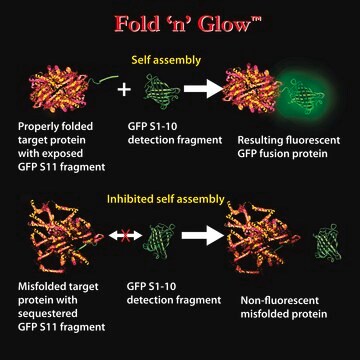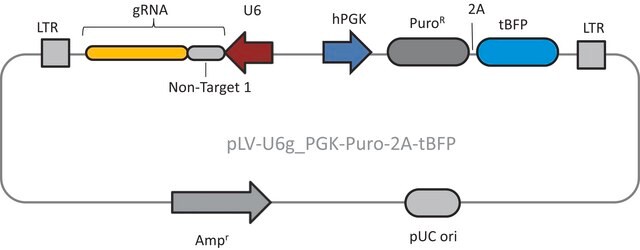Wszystkie zdjęcia(1)
Kluczowe dokumenty
APPA001
In Vitro Bacterial Split GFP Fold ′n′ Glow™ Solubility Assay Kit (green)
Zaloguj sięWyświetlanie cen organizacyjnych i kontraktowych
About This Item
Kod UNSPSC:
12352204
NACRES:
NA.54
Polecane produkty
metody
protein expression: suitable
Poziom jakości
Warunki transportu
dry ice
temp. przechowywania
−20°C
Zastosowanie
The Fold ′n′ Glow Protein Solubility Assay kit allows a test protein to be expressed as an N-terminal fusion with a fluorescent protein [i.e., Green Fluorescent Protein (GFP), Cyan Fluorescent Protein (CFP), and Yellow Fluorescent Protein (YFP)]. This allows the detection of protein properly folded in a given sample as the folding reporter gives a signal directly proportional to the amount of correctly folded protein. The kit can be used for the detection and quantification of any protein by tagging and detecting either soluble or insoluble proteins.
Cechy i korzyści
Fluorescent protein (GFP, CFP, or YFP) fusions and split protein tags are widely used for the analysis of protein. These large tags can perturb protein solubility, misfold, and alter the processing of the protein. The split fluorescent protein technology used in the “Fold ′n′ Glow” assay overcomes these problems. The protein tag is a genetically encoded, split fluorescent protein technology, engineered with small, soluble, self-associating fragments. Thus, it is a simple split fluorescent protein system that doesn′t change fusion protein solubility, or require chemical ligation, fused interacting partners, co-expression, or co-refolding. Furthermore, while fluorogenic biarsenical FlaSH or ReASH substrates also overcome these limitations, they also require many other conditions not necessarywhen using the split fluorescent protein technology. Thefluorescent protein system is a simple and easy tagging and detection system. These kits may be used to quantify the expression level of the tagged protein, to determine the solubility of a protein, or to determine the solubility of a protein′s domain.
Przydatność
This kit contains sufficient reagents for one 96 well plate (96 tests)
Zasada
The kit is a protein tagging and detection method that uses split fluorescent protein technology in a fluorescent complementation assay. The protein to be quantified is fused to a small fluorescent protein fragment (contained in the S11 plasmid) via a flexible linker. Expressed separately, neither the fusion protein of interest nor the fluorescent protein detector (Universal Detection Reagent S1-10) is fluorescent. When mixed, the properly folded fusion protein and detector spontaneously associate, completing the fluorophore. Misfolding or aggregation of the fusion protein makes the fluorescent protein tag inaccessible and prevents complementation, thus preventing fluorescence. Therefore, misfolded or aggregated proteins are not included in the quantification of the protein of interest.
Informacje prawne
Fold 'n' Glow is a trademark of Sandia BioTech
Ta strona może zawierać tekst przetłumaczony maszynowo.
Kod klasy składowania
10 - Combustible liquids
Temperatura zapłonu (°F)
Not applicable
Temperatura zapłonu (°C)
Not applicable
Wybierz jedną z najnowszych wersji:
Masz już ten produkt?
Dokumenty związane z niedawno zakupionymi produktami zostały zamieszczone w Bibliotece dokumentów.
G S Waldo et al.
Nature biotechnology, 17(7), 691-695 (1999-07-15)
Formation of the chromophore of green fluorescent protein (GFP) depends on the correct folding of the protein. We constructed a "folding reporter" vector, in which a test protein is expressed as an N-terminal fusion with GFP. Using a test panel
Stéphanie Cabantous et al.
Nature biotechnology, 23(1), 102-107 (2004-12-08)
Existing protein tagging and detection methods are powerful but have drawbacks. Split protein tags can perturb protein solubility or may not work in living cells. Green fluorescent protein (GFP) fusions can misfold or exhibit altered processing. Fluorogenic biarsenical FLaSH or
Global Trade Item Number
| SKU | GTIN |
|---|---|
| APPA001-1KT | 4061826723142 |
Nasz zespół naukowców ma doświadczenie we wszystkich obszarach badań, w tym w naukach przyrodniczych, materiałoznawstwie, syntezie chemicznej, chromatografii, analityce i wielu innych dziedzinach.
Skontaktuj się z zespołem ds. pomocy technicznej





